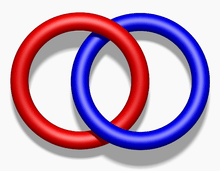Hopf link
 | |
| Braid length | 2 |
|---|---|
| Braid no. | 2 |
| Crossing no. | 2 |
| Hyperbolic volume | 0 |
| Linking no. | 1 |
| Stick no. | 6 |
| Unknotting no. | 1 |
| A-B notation |
22 1 |
| Thistlethwaite | L2a1 |
| Last /Next | L0 / L4a1 |
| Other | |
| alternating, torus, fibered | |
In mathematical knot theory, the Hopf link is the simplest nontrivial link with more than one component.[1] It consists of two circles linked together exactly once,[2] and is named after Heinz Hopf.[3]
Geometric realization
A concrete model consists of two unit circles in perpendicular planes, each passing through the center of the other.[2] This model minimizes the ropelength of the link and until 2002 the Hopf link was the only link whose ropelength was known.[4] The convex hull of these two circles forms a shape called an oloid.[5]
Properties
Depending on the relative orientations of the two components the linking number of the Hopf link is ±1.[6]
The Hopf link is a (2,2)-torus link[7] with the braid word[8]
The knot complement of the Hopf link is R × S1 × S1, the cylinder over a torus.[9] This space has a locally Euclidean geometry, so the Hopf link is not a hyperbolic link. The knot group of the Hopf link (the fundamental group of its complement) is Z2 (the free abelian group on two generators), distinguishing it from an unlinked pair of loops which has the free group on two generators as its group.[10]
The Hopf-link is not tricolorable. This is easily seen from the fact that the link can only take on two colors that leads it to fail the second part of the definition of tricoloribility. At each crossing, it will take a maximum of 2 colors. Thus, if it satisfies the rule of having more than 1 color, it fails the rule of having 1 or 3 color at each crossing. If it satisfies the rule of having 1 or 3 colors at each crossing, it will fail the rule of having more than 1 color.
Hopf bundle
The Hopf fibration is a continuous function from the 3-sphere (a three-dimensional surface in four-dimensional Euclidean space) into the more familiar 2-sphere, with the property that the inverse image of each point on the 2-sphere is a circle. Thus, these images decompose the 3-sphere into a continuous family of circles, and each two distinct circles form a Hopf link. This was Hopf's motivation for studying the Hopf link: because each two fibers are linked, the Hopf fibration is a nontrivial fibration. This example began the study of homotopy groups of spheres.[11]
History

The Hopf link is named after topologist Heinz Hopf, who considered it in 1931 as part of his research on the Hopf fibration.[12] However, in mathematics, it was known to Carl Friedrich Gauss before the work of Hopf.[3] It has also long been used outside mathematics, for instance as the crest of Buzan-ha, a Japanese Buddhist sect founded in the 16th century.
See also
- Catenane, a molecule with two linked loops
- Solomon's knot, two loops which are doubly linked
References
- ↑ Adams, Colin Conrad (2004), The Knot Book: An Elementary Introduction to the Mathematical Theory of Knots, American Mathematical Society, p. 151, ISBN 9780821836781.
- 1 2 Kusner, Robert B.; Sullivan, John M. (1998), "On distortion and thickness of knots", Topology and geometry in polymer science (Minneapolis, MN, 1996), IMA Vol. Math. Appl., 103, New York: Springer, pp. 67–78, doi:10.1007/978-1-4612-1712-1_7, MR 1655037. See in particular p. 77.
- 1 2 Prasolov, V. V.; Sossinsky, A. B. (1997), Knots, links, braids and 3-manifolds: An introduction to the new invariants in low-dimensional topology, Translations of Mathematical Monographs, 154, Providence, RI: American Mathematical Society, p. 6, ISBN 0-8218-0588-6, MR 1414898.
- ↑ Cantarella, Jason; Kusner, Robert B.; Sullivan, John M. (2002), "On the minimum ropelength of knots and links", Inventiones Mathematicae, 150 (2): 257–286, arXiv:math/0103224
 , doi:10.1007/s00222-002-0234-y, MR 1933586.
, doi:10.1007/s00222-002-0234-y, MR 1933586. - ↑ Dirnböck, Hans; Stachel, Hellmuth (1997), "The development of the oloid" (PDF), Journal for Geometry and Graphics, 1 (2): 105–118, MR 1622664.
- ↑ Adams (2004), p. 21.
- ↑ Kauffman, Louis H. (1987), On Knots, Annals of Mathematics Studies, 115, Princeton University Press, p. 373, ISBN 9780691084350.
- ↑ Adams (2004), Exercise 5.22, p. 133.
- ↑ Turaev, Vladimir G. (2010), Quantum Invariants of Knots and 3-manifolds, De Gruyter studies in mathematics, 18, Walter de Gruyter, p. 194, ISBN 9783110221831.
- ↑ Hatcher, Allen (2002), Algebraic Topology, p. 24, ISBN 9787302105886.
- ↑ Shastri, Anant R. (2013), Basic Algebraic Topology, CRC Press, p. 368, ISBN 9781466562431.
- ↑ Hopf, Heinz (1931), "Über die Abbildungen der dreidimensionalen Sphäre auf die Kugelfläche", Mathematische Annalen, Berlin: Springer, 104 (1): 637–665, doi:10.1007/BF01457962.
External links
| Wikimedia Commons has media related to Hopf links. |